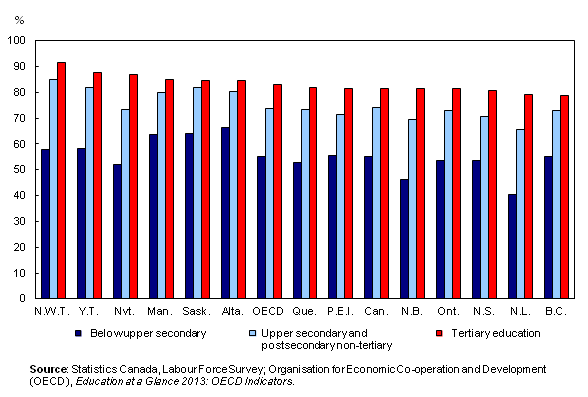Education indicators in Canada: An international perspective, 2013
Archived Content
Information identified as archived is provided for reference, research or recordkeeping purposes. It is not subject to the Government of Canada Web Standards and has not been altered or updated since it was archived. Please "contact us" to request a format other than those available.
Released: 2014-01-07
Almost 9 out of 10 people (89%) aged 25 to 64 had completed at least high school in 2011 in Canada, substantially higher than the Organisation for Economic Co-operation and Development (OECD) average of 75%. Among reporting countries, only the Czech Republic (92%) and the Slovak Republic (91%) posted higher proportions.
Nationally, British Columbia (92%), Ontario (91%) and Alberta (89%) were all at or above the Canadian average. In all other jurisdictions but Nunavut (54%), the proportion of 25 to 64 year-olds who had completed at least high school ranged from 79% in the Northwest Territories to 88% in Saskatchewan and Yukon.
Canada had a high proportion of individuals with a university degree compared with most other OECD countries.
Almost two-thirds (64%) of Canadians aged 25 to 64 had completed a postsecondary education in 2011. Overall, the proportion of individuals who had a university degree (bachelor's to PhD) was 27%, with nine OECD countries recording figures above Canada's. Those attaining a postsecondary education at the college, trade, vocational or university certificate below bachelor's level comprised 37% of Canadians aged 25 to 64. This is partly a reflection of Canada's extensive network of colleges, one not seen in most other OECD countries.
In Canada, 7.5% of all enrolments in tertiary (college and university) programs in 2010 were individuals from other countries, accounting for over 100,000 international students. Almost three-quarters (72%) of these international students were enrolled in Canada's undergraduate and master's university programs that year. China accounted for the largest proportion of international students (26.9%), followed by the United States (7.7%), France (7.4%), India (6.0%) and South Korea (4.4%).
Higher levels of education are linked to improved employment prospects. In Canada in 2011, the employment rate for adults aged 25 to 64 who had not completed upper secondary education (high school) was 55%. In comparison, the employment rate among the same age group was highest for individuals who had a college or university credential: 82%, similar to the OECD average.
The resources devoted to education vary across the OECD, as measured by the share of gross domestic product (GDP). In 2009, Canada spent 6.7% of its GDP on education; this compares with the OECD average of 6.3%. Nationally, the share of GDP devoted to educational institutions varied from 5.5% in Alberta to 8.8% in Nunavut.
Staff compensation is the largest single expense of educational institutions in Canada. At the primary and secondary levels, it accounted for 77.4% of current expenditure in Canada in 2009, a situation mirrored in all other OECD countries. At the tertiary (college and university) level, staff compensation accounted for 64.7%.
Teachers in Canada reached the top of their salary scales much more quickly than their counterparts in other OECD countries. Information collected on teacher's salaries reveals that in Canada, on average, it takes 11 years to reach the top of a salary scale, compared with an OECD average of 24 years.
However, teachers in Canada, on average, spend more time teaching than their OECD counterparts. For example, Canadian primary teachers averaged 799 hours per year in 2010/2011, compared with an average of 790 for the OECD countries overall. The same differences are reflected at the lower secondary level (generally Grades 7 to 9), with 743 hours per year in Canada versus 709 hours for the OECD average. For the upper secondary level (generally Grades 10 to 12), Canadian teachers taught an average of 747 hours, compared with 646 hours for the OECD overall.
Note to readers
Education Indicators in Canada: An International Perspective, 2013, is the fifth in a series of reports designed to complement the OECD's annual report on education indicators, Education at a Glance.
The 11 indicators presented in this 2013 Canadian compendium represent a selection of indicators that were developed to align with the definitions and methodologies used by the OECD in its most recent report, Education at a Glance 2013: OECD Indicators. Data for Canada and its provinces and territories were drawn from several data sources and various reference years, as required to provide comparisons with OECD figures.
The 2013 indicator set for Canada, the provinces and territories captures information on educational attainment, graduation and completion rates at the secondary level, labour market outcomes, expenditures per student, expenditures on education, international students, transitions to the labour market and the learning environment and organization of schools.
The information contained in the report was prepared by the Canadian Education Statistics Council, a joint venture of Statistics Canada and the Council of Ministers of Education, Canada. The report is part of the Pan-Canadian Education Indicators Program of Statistics Canada.
Data for the 34 OECD member countries are from the OECD publication Education at a Glance 2013: OECD Indicators, available on the OECD website (www.oecd.org).
The publication Education Indicators in Canada: An International Perspective, 2013 (Catalogue number81-604-X), is now available from the Browse by key resource module of our website under Publications.
Contact information
For more information, or to enquire about the concepts, methods or data quality of this release, contact us (toll-free 1-800-263-1136; 514-283-8300; infostats@statcan.gc.ca) or Media Relations (613-951-4636; statcan.mediahotline-ligneinfomedias.statcan@canada.ca).
- Date modified:


